Input interpretation

choline glycerophosphate
Chemical names and formulas
![formula | C_8H_20NO_6P name | choline glycerophosphate IUPAC name | 2-[[(2S)-2, 3-dihydroxypropoxy]-oxido-phosphoryl]oxyethyl-trimethyl-azanium alternate names | glycerophosphorylcholine | sn-glycero-3-phosphocholine mass fractions | C (carbon) 37.4% | H (hydrogen) 7.84% | N (nitrogen) 5.45% | O (oxygen) 37.3% | P (phosphorus) 12%](../image_source/f2e3ca578009cb958b3e3d89613fdb44.png)
formula | C_8H_20NO_6P name | choline glycerophosphate IUPAC name | 2-[[(2S)-2, 3-dihydroxypropoxy]-oxido-phosphoryl]oxyethyl-trimethyl-azanium alternate names | glycerophosphorylcholine | sn-glycero-3-phosphocholine mass fractions | C (carbon) 37.4% | H (hydrogen) 7.84% | N (nitrogen) 5.45% | O (oxygen) 37.3% | P (phosphorus) 12%
Lewis structure
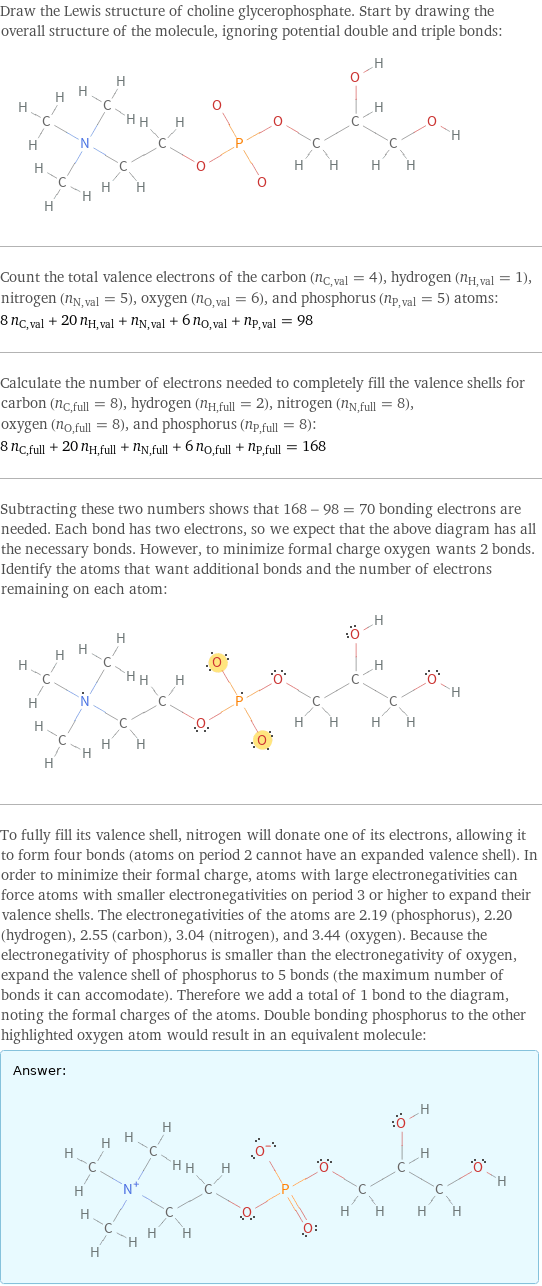
Draw the Lewis structure of choline glycerophosphate. Start by drawing the overall structure of the molecule, ignoring potential double and triple bonds: Count the total valence electrons of the carbon (n_C, val = 4), hydrogen (n_H, val = 1), nitrogen (n_N, val = 5), oxygen (n_O, val = 6), and phosphorus (n_P, val = 5) atoms: 8 n_C, val + 20 n_H, val + n_N, val + 6 n_O, val + n_P, val = 98 Calculate the number of electrons needed to completely fill the valence shells for carbon (n_C, full = 8), hydrogen (n_H, full = 2), nitrogen (n_N, full = 8), oxygen (n_O, full = 8), and phosphorus (n_P, full = 8): 8 n_C, full + 20 n_H, full + n_N, full + 6 n_O, full + n_P, full = 168 Subtracting these two numbers shows that 168 - 98 = 70 bonding electrons are needed. Each bond has two electrons, so we expect that the above diagram has all the necessary bonds. However, to minimize formal charge oxygen wants 2 bonds. Identify the atoms that want additional bonds and the number of electrons remaining on each atom: To fully fill its valence shell, nitrogen will donate one of its electrons, allowing it to form four bonds (atoms on period 2 cannot have an expanded valence shell). In order to minimize their formal charge, atoms with large electronegativities can force atoms with smaller electronegativities on period 3 or higher to expand their valence shells. The electronegativities of the atoms are 2.19 (phosphorus), 2.20 (hydrogen), 2.55 (carbon), 3.04 (nitrogen), and 3.44 (oxygen). Because the electronegativity of phosphorus is smaller than the electronegativity of oxygen, expand the valence shell of phosphorus to 5 bonds (the maximum number of bonds it can accomodate). Therefore we add a total of 1 bond to the diagram, noting the formal charges of the atoms. Double bonding phosphorus to the other highlighted oxygen atom would result in an equivalent molecule: Answer: | |
3D structure

3D structure
Basic properties
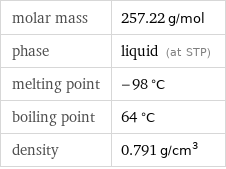
molar mass | 257.22 g/mol phase | liquid (at STP) melting point | -98 °C boiling point | 64 °C density | 0.791 g/cm^3
Units

Hydrophobicity and permeability properties

predicted LogP hydrophobicity | -2.46 predicted LogS | -1.86
Basic drug properties

approval status | experimental | small molecule
Liquid properties (at STP)
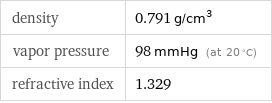
density | 0.791 g/cm^3 vapor pressure | 98 mmHg (at 20 °C) refractive index | 1.329
Units

Chemical identifiers
(C)CCOP(=O)([O-])OCC(CO)O InChI identifier | InChI=1/C8H20NO6P/c1-9(2, 3)4-5-14-16(12, 13)15-7-8(11)6-10/h8, 10-11H, 4-7H2, 1-3H3/t8-/m0/s1 InChI key | SUHOQUVVVLNYQR-RVEYGKOVDE EU number | 248-962-2 RTECS number | KH2775000](../image_source/6ba7190385678d06ad19167ca51f94c4.png)
CAS number | 28319-77-9 Beilstein number | 6062450 PubChem CID number | 71920 PubChem SID number | 7886583 SMILES identifier | C[N+](C)(C)CCOP(=O)([O-])OCC(CO)O InChI identifier | InChI=1/C8H20NO6P/c1-9(2, 3)4-5-14-16(12, 13)15-7-8(11)6-10/h8, 10-11H, 4-7H2, 1-3H3/t8-/m0/s1 InChI key | SUHOQUVVVLNYQR-RVEYGKOVDE EU number | 248-962-2 RTECS number | KH2775000
NFPA label

NFPA label
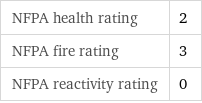
NFPA health rating | 2 NFPA fire rating | 3 NFPA reactivity rating | 0
Safety properties
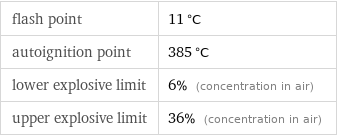
flash point | 11 °C autoignition point | 385 °C lower explosive limit | 6% (concentration in air) upper explosive limit | 36% (concentration in air)

DOT hazard class | 3 DOT numbers | 1230
Toxicity properties

RTECS classes | drug